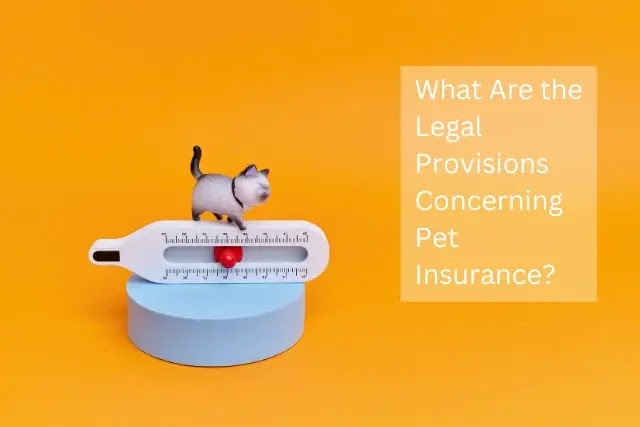Introduction:
Starting with this article, we embark on a journey through the legal landscape surrounding an increasingly important aspect of our lives as pet owners – pet insurance. As more and more people welcome furry companions into their homes, the significance of ensuring their well-being through insurance becomes undeniable. However, navigating the legal provisions governing pet insurance can be a complex task.
In this discussion, we will unravel the legal intricacies surrounding pet insurance. From understanding the regulations that oversee the pet insurance industry to knowing your rights and obligations as a policyholder, we aim to shed light on the legal provisions that shape this crucial aspect of pet care.
As pet insurance continues to evolve and become an integral part of responsible pet ownership, knowledge of the legal framework is essential. This article serves as a guide to help you navigate the legal aspects of pet insurance, empowering you to make informed decisions for the health and security of your beloved animal companions.
- Regulatory framework for pet insurance.
- Policy terms, conditions, and disclosures.
- Consumer rights and protections.
- Claims handling and dispute resolution.
- State-specific regulations and variations.
- Emerging legal trends in pet insurance.
Regulatory Framework for Pet Insurance:
Pet insurance is subject to regulatory oversight that varies from one region to another. In the United States, for example, pet insurance is primarily regulated at the state level. This means that each state can have its own set of rules and requirements for pet insurance providers. Some states may classify pet insurance as a form of property and casualty insurance, while others may categorize it differently.
Additionally, in some countries, pet insurance may fall under the purview of national insurance regulators. Understanding the regulatory framework that applies to pet insurance in your area is crucial. It can dictate the standards for policy terms, consumer protections, and other aspects of pet insurance.
Policy Terms, Conditions, and Disclosures:
Legal provisions related to pet insurance often require insurers to provide clear and transparent policy terms, conditions, and disclosures to consumers. This includes detailed information about what the policy covers, any limitations or exclusions, premium costs, deductibles, and co-payments. Insurers are generally obligated to provide potential policyholders with a copy of the policy terms before purchase.
These provisions are essential to ensure that consumers fully understand what they are buying and can make informed decisions about the level of coverage they need for their pets. Additionally, it helps prevent deceptive practices or hidden terms that could negatively impact policyholders.
Consumer Rights and Protections:
Pet insurance legal provisions often include consumer rights and protections. These may encompass the right to cancel a policy within a certain timeframe, the right to a fair claims process, and the right to dispute claim denials. Consumers have the right to expect prompt and fair treatment from insurers when filing claims and seeking reimbursements for veterinary expenses.
Legal provisions may also outline the responsibilities of insurers in providing accurate information to consumers and handling policyholder inquiries. It’s essential for consumers to be aware of their rights and protections under the law when dealing with pet insurance companies.
Claims Handling and Dispute Resolution:
Pet insurance policies typically include provisions related to claims handling and dispute resolution. These provisions define the process for filing claims, the timeframes for claim processing, and the steps to take if a claim is denied or disputed. The legal framework aims to ensure that policyholders have a fair and efficient means of resolving disputes with insurers.
Common dispute resolution methods may include arbitration or mediation, depending on the terms of the policy and applicable laws. Understanding the claims handling and dispute resolution processes is vital for policyholders to navigate any issues that may arise during the course of their pet’s medical care.
State-Specific Regulations and Variations:
As mentioned earlier, pet insurance regulations often vary by state or region. State-specific laws can impact everything from policy pricing to the types of coverage that must be offered. Some states have more stringent regulations that require specific disclosures or consumer protections, while others have minimal requirements.
Policyholders should be aware of the regulatory environment in their specific location to ensure they receive the protections and benefits mandated by local laws. This may include understanding any state-specific variations in coverage options, pricing, or claims processes.
Emerging Legal Trends in Pet Insurance:
The landscape of pet insurance is continually evolving, and legal provisions may adapt to emerging trends. In recent years, there has been a growing focus on transparency in policy terms, coverage for alternative therapies, and the treatment of pre-existing conditions. Some legal developments aim to improve consumer rights and protections in the pet insurance industry.
Policyholders and prospective pet insurance buyers should stay informed about these emerging legal trends. This can help them make informed decisions about their pet’s coverage and ensure that they receive the benefits and protections they deserve under the law.
The legal provisions concerning pet insurance encompass a wide range of topics, including regulatory frameworks, policy disclosures, consumer rights, claims handling, state-specific variations, and emerging trends. Understanding these legal aspects is crucial for both consumers and insurers to ensure fair and transparent practices in the pet insurance industry. By being informed about the legal provisions that apply to pet insurance, consumers can make well-informed decisions and protect the health and well-being of their beloved pets.
Conclusion:
I hope this exploration of the legal provisions concerning pet insurance has shed light on the critical aspects that both policyholders and insurers should be aware of in this evolving industry. In conclusion, the legal framework surrounding pet insurance serves to protect the interests of both pet owners and insurance providers.
Understanding the regulatory framework, policy terms, and consumer protections is vital for pet owners seeking the right coverage for their furry companions. It ensures transparency, fairness, and the ability to make informed choices about pet insurance policies. Likewise, insurers must adhere to these legal provisions to maintain trust and integrity in the industry.
As the pet insurance landscape continues to evolve, staying informed about emerging legal trends and state-specific variations becomes increasingly important. This knowledge empowers pet owners to make informed decisions about their pet’s healthcare, ultimately leading to better outcomes for our beloved animal companions. In the end, a well-informed and legally protected pet insurance industry benefits everyone involved, fostering a healthier and more secure future for our pets.

